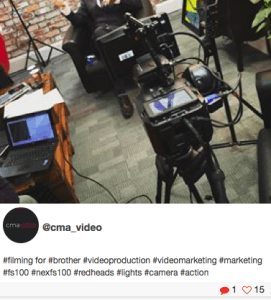We all know that well used phrase – ‘content is king’ and how its all about providing quality marketing content for your clients, customers, subscribers and fans but how often is it actually adhered to? Knowing what content needs to be created and actually producing it are very often two different things and knowing what content your audience actually wants to consume is another matter altogether.
This can apply to any form of marketing content and its getting even more crucial as customers get more savvy about what they want to receive and how they receive it. It used to be about providing informative, useful information but not any more. Consumers are looking to be stimulated, inspired and even entertained – when it comes to something like a video marketing campaign, you are actually invading your audience’s valuable time so it’d better be worth watching. As channels give access to video on an ever increasing level it has to stand out as something that grabs the attention.

Each channel also dictates the content style and has its own community. Facebook for example has autoplay with no sound on its videos meaning that the visuals are key here while a YouTube advert gives you just five seconds before the viewer can skip the advert completely. Instagram on the other hand allows for just 15 second videos in total, without sound so another different approach is required again. From that alone there are three different introduction styles to account for each platform before you even consider the demographics of each of those channels.

In addition, there is a leaning towards not just communicating with customers anymore but actually creating a community that your audience feels part of and, perhaps more importantly, contributes to. The evolving consumer wants to have say in brands’ activities, wants to feel part of a brand and increasingly is looking to align themselves with a brand’s values – this is where the content needs to move up a level. Brands such as apple or Victoria’s Secret work hard on creating a community of followers who engage with the brands and feel part of them. They thrive on the idea that they have an opportunity to shape what the brand is doing and react to new developments either in a positive or negative way. This may, on occasion, hamper or derail some activities that brands look to undertake but the value of creating such strong brand loyalty far outweighs any amendments or u-turns that may need to be taken every once in a while. Building up a strong community around a brand effectively creates an army of brand ambassadors and advocates which give more credence to a product than any marketing department or advertising campaign will.
Once these actions have helped to build a community then it can start to stimulate conversation amongst that community. This again creates ambassadors for a brand and again more importantly, makes consumers feel part of a brand, movement or cause. The downside to something like this is that the brand has little control where the conversation will go but with the use of carefully created content, the conversation can be steered in the right direction. In addition, engaging in the conversation can strengthen the consumers’ bond with the brand if they know that their voices are being heard. The conversation element also helps a brand stay current and on top of the trending/search stakes. The more a brand is the subject of online chatter the more it is likely to be found and continue to be seen as interesting to those in and on the outside of the community.
Looking back to the concept of ‘content is king’, video is not the only method but is certainly one of the most effective ways of creating good content, developing a community and engaging in conversation with customers. A well crafted and structured video strategy will serve this well with a variety of content options available from video blogs to creative adverts to event filming and plenty more.
From a marketing perspective, this is where there needs to be a shift of how you produce content. Its difficult for a brand to produce one video that serves as ‘catch all’ for everything it does and then expect to build a community on the back of that one video. Short videos, produced on a regular basis would be ideal for this type of objective where you can respond to issues and situations, show new products or developments in an engaging way and be really creative in the way that you present your brand.
You can’t simply talk at an audience anymore and assume that you have what they want, brands need to understand their customers and give them content which actually resonates with them. This means that a brand may need to be a bit more flexible and show some fluidity on the marketing content they produce – if there is a known or perceived shift on a subject that their audience relates to, a brand may have to reflect that shift. This can show firstly that you truly understand your customer but also demonstrates a willingness to learn and grow with your customer too.
The world of content marketing has changed significantly and consumers now expect more. Its not just about telling the world what you do, now its about informing and engaging with your audience. Outbound marketing is all about interruption into your audience’s world while inbound marketing content is about attracting your audience.